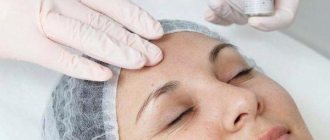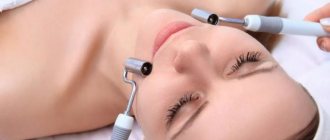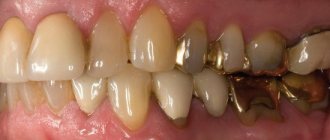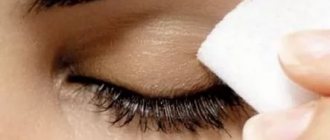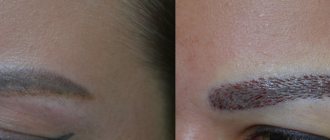Eyelash transplant is a unique operation that is popular among women. Eyelashes are a barrier that protects the eyes from dust and foreign bodies. Injuries or diseases can thin out or destroy the fluffy frame and eat away bald spots in it. Cosmetic procedures cannot save the situation; the only solution is a hair transplant.
What is and features of eyelash transplantation
Eyelash transplantation is the transfer of a hair from a donor to the eyelid.
It is performed with a special needle. Someone else's eyelash falls out over time, being replaced by one that grows on its own.
Doctors divide candidates for surgery into two main categories:
- People in need of a restorative transplant. The cause of eyelash loss is damage that leads to disruption of the integrity of the hair bulb and root, which makes further growth impossible.
- Those wishing to increase the volume or length of existing eyelashes. The doctor considers the wishes of such clients on an individual basis, assessing the possibility of transferring and engrafting donor material.
In the first case, doctors have large-scale work ahead of them. The first stage is an assessment of the following important factors:
- whether the affected tissues have the ability to accept and carry transplanted follicles and hairs;
- whether the donor material will be collected in the required volume and quality.
For restorative transplantation, patients who have lost eyelashes as a result of cancer must undergo examination and diagnostics.
The surgeon determines the stage of the underlying disease (active or remission, the duration of the period during which the disease does not manifest itself), and the list of medications used.
Transplantation is contraindicated if the main factor of eyelash loss has not been eliminated.
Cancer that has gone into remission requires time for the body to recover. On average the period lasts 2 years.
Eyelash transplant surgery for patients with trichotillomania is carried out strictly after taking the obsessive condition under constant control. Consultations with a psychiatrist are required.
The restoration procedure after damage to the skin of the eyes is carried out after their complete healing and restoration.
BUILDING OF THE CENTURY
Anatomy of the century
Eyelids are movable folds of skin around a person's eyes. They protect the eyes from external damage, promote their wetting with tear fluid, and cleanse the cornea and sclera. In mammals, eyelashes and gland openings are located on the free edge of the eyelids.
The glands of the eyelids include:
- The lacrimal glands produce about 1 milliliter of tears per day. This amount varies depending on stress (sadness or joy), mechanical or chemical irritation, and the use of medications. Tear production may be reduced due to medications that affect the tear glands;
- Auxiliary lacrimal glands secrete an oily substance, which, when mixed with tears, creates a protective coating on the eyeball;
- System for washing the eye and removing fluids and foreign bodies. The inner part of the eyelid, which is in direct contact with the eyeball, is the mucous membrane. Its inflammation or infection is called conjunctivitis.
Any neoplasm is a reason for medical examination. Eyelash transplantation should not be performed until the tumor has been diagnosed or removed. The so-called “stye” is an inflammation of the auxiliary lacrimal glands.
Reconstructive transplantation
When transplanting eyelashes, two factors must be taken into account: (1) the biological ability of the damaged tissue to become a carrier of transplanted hair and follicles and (2) the availability of donor material of the required quality and quantity.
For patients who have lost eyelashes as a result of any disease, the following factors are taken into account:
- Whether the disease is active or in remission;
- What medications are used to combat it.
If the cause of eyelash loss is not eliminated, transplantation cannot be started. If the disease is in remission, a certain amount of time must pass. Typically this period is at least two years.
Patients with trichotillomania do not undergo eyelash transplantation until the obsessive disorder is completely under control. In such cases, eyelash transplantation is preceded by consultations with psychiatrists. The patient may deny the fact of self-pulling hair, even if there are clear signs of the opposite on the face - areas of baldness and broken eyelashes. The psychopathology of trichotillomania is not fully understood, but it may be a form of obsessive-compulsive disorder.
Patients with damaged eyelid tissues should wait until they are completely restored.
Potential candidates for eyelash transplant
As a rule, candidates are divided into 2 groups according to purpose:
- Restorative transplantation of eyelashes lost as a result of injury. Patients with a complete absence of hair cannot undergo this procedure due to the lack of donor material, but artificial substitutes glued to the eyelids can be used;
- Transplantation (eyelash transplant) for aesthetic purposes.
Aesthetic transplantation
The goal of aesthetic transplantation is thickness (adding eyelashes between existing ones) or length (the transplanted eyelashes grow longer than natural ones). In some cases, transplantation is not recommended:
- The expected result is not worth the money requested for the procedure, the time and the discomfort caused;
- The likelihood that the patient has an obsessive condition in which he inadequately evaluates his appearance. Such people are overly concerned with their appearance, constantly looking for ways to improve something and resort to aesthetic surgery. A typical case is a patient with no visible defects in appearance, but with an obsession with fixing something. Typically, this condition is identified during a questionnaire and conversation with a doctor. Then a consultation with a psychologist or psychiatrist is required, who must either diagnose an obsessive state or distinguish it from a simple desire to improve one’s appearance.
Indications for the procedure
Transplantation of donor material allows you to restore eyelashes lost as a result of:
- chemotherapy in the treatment of cancer;
- congenital atrichia - a disease characterized by the absence of hair on the entire body;
- physical injury caused by open fire or chemicals;
- formation of scar tissue after a car or man-made disaster;
- trichotillomania - a psychological pathology in which a person pulls out hair on the head and face;
- unsuccessful extension and lamination procedures.
Are there any contraindications?
Yes, although the procedure is simple, there are some contraindications:
- severe disturbances in the anatomy of the eyelids, caused by burns and injuries;
- worsened trichotillomania;
- cancer, severe anemia and other diseases that can cause hair loss;
- clear signs of baldness in the donor area;
- the patient has a tendency to form keloid scars.
There are no more obvious contraindications. If you do not experience the phenomena described above, you can safely contact foreign clinics for eyebrow and eyelash transplantation.
Transplantation methods and where hairs come from
Hair transplantation onto eyelids is possible using two techniques.
- Collective method. Donor hair follicles are collected in groups. Transplants or grafts are cut from the back of the head (occiput) in three follicles with stems trimmed to 3-4 mm. The doctor tries to take areas with a minimum amount of surrounding tissue. The seized material is placed in a special needle with a bend. It is used to transfer the graft into incisions on the surface of the eyelids made along the eyelash line. The implanted hair dies 2 weeks after the procedure, but the follicle manages to strengthen. After 3-4 months, a new eyelash begins to grow from it. Disadvantages of the technique: increased sensitivity of the skin of the eyelids can cause swelling and hematomas; The different thickness of the transplanted skin from the head and eyelid causes uneven edges of the eye curtain.
- Individual method. Hair from the back of the head is transferred one unit at a time. The graft is placed in a curved needle and inserted into the dermis to the permissible depth. The parameter is controlled by a high-precision optical device. Before the transplant begins, the tip of the hair is ground down and shortened to give future eyelashes a natural look. Delicate spot work is more difficult to perform, but allows you to get the most natural result without bruising or swelling.
Indications for the method are partial loss of eyelashes as a result of operations and injuries.
History of development
- The eyelash transplant procedure was first described in 1914 in the German Medical Weekly. A certain Crusius Franz posted an article “Implantation of living hair for the formation of eyelashes.” The article is purely theoretical, but it is considered the first step in advancing such a complex procedure.
- In 1917, Knapp transplanted hair grafts from the eyebrows to the borders of the eyelids.
- In 1929, researcher Sasagawa uses specially designed needles to implant human hair into the subcutaneous tissue.
- In 1953, Dr. Fujita managed to make pinpoint insertions using an injection needle.
- In 1980, Marritt used a solid needle to insert hair follicles collected from the periphery into 4-mm perforator grafts into the eyelid margin.
Technique of cutting and inserting the hair follicle using a needle into the eyelid border
How does a transplant operation take place?
Transplantation begins with the preparatory stage. To avoid bleeding during and after surgery, to avoid complications such as infection, the patient must:
- a week before the scheduled transplant date, stop taking Warfarin, Aspirin and other drugs that affect blood clotting;
- do not drink alcoholic beverages for several days;
- stop taking vitamin E;
- undergo a course of antibacterial therapy;
- use special detergents for facial hygiene.
Postoperative period
Need advice from a beauty expert?
Get advice from a beauty expert online. Ask your question right now.
ask a free question
On the first day after transplant surgery, the patient may experience severe or moderate itching in the eyelid area. The discomfort persists for several days. A prolonged desire to scratch your eyes indicates the development of complications and requires medical supervision. Touching the eyes is prohibited. To eliminate itching, ophthalmic drops, cold compresses and mild analgesics are used.
To prevent new eyelashes from falling out, you need to sleep with special glasses.
Some experts do not advise removing the protective post-operative bandage from the face during the first 24 hours. Reduces the risk of bleeding and infection.
During the entire recovery period after transplantation, it is prohibited to take drugs that affect blood clotting.
Rehabilitation lasts from 7 to 14 days, depending on the individual characteristics of the body and the chosen transplantation technique.
New eyelashes need to be trimmed and curled with a curling iron. Their growth begins immediately after the operation, the length is not limited in any way.
Rehabilitation process
The rehabilitation period after such surgical interventions is not difficult or long. The duration of rehabilitation sometimes does not exceed 4 days.
After eyelash transplant operations, doctors transfer the patient to a special diet, which includes foods containing large quantities of vitamins C, B, and A. The places where the donor material was taken and the eyelids must be lubricated with antiseptic materials and ointments. Based on the decision of the attending physician, a procedure (laser therapy) is prescribed to stimulate the follicles.
The use of cosmetics may only be permitted after consultation with a doctor. Usually the doctor allows cosmetics after a month. In addition to this, it is recommended to buy high-quality cosmetics with natural ingredients.
It is also recommended to avoid sunlight, which can discolor new eyelashes. During the first month of rehabilitation, visiting the solarium is prohibited.
It is important to know that the transplanted hair will be longer. It is recommended to adjust them several times during the rehabilitation course.


